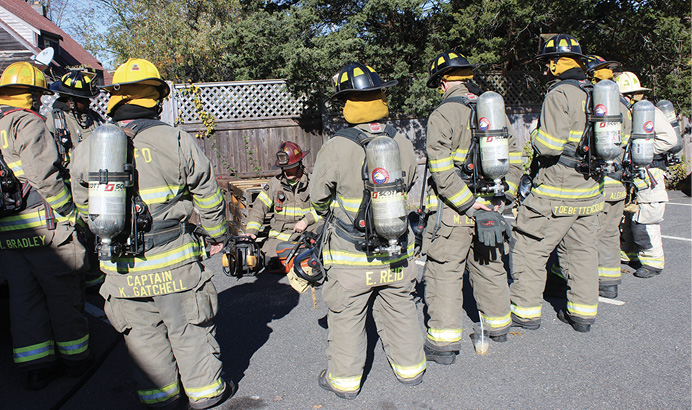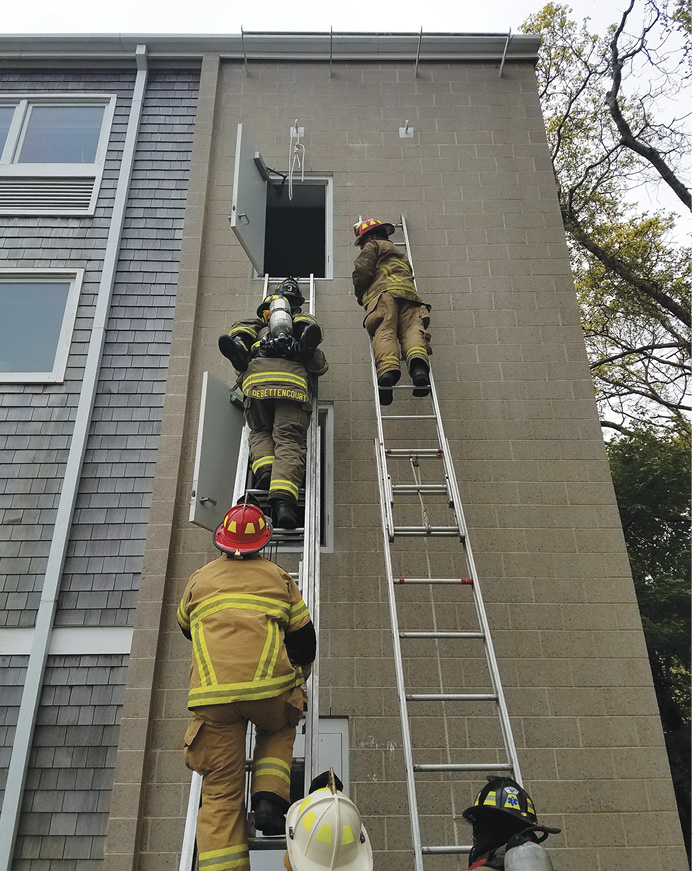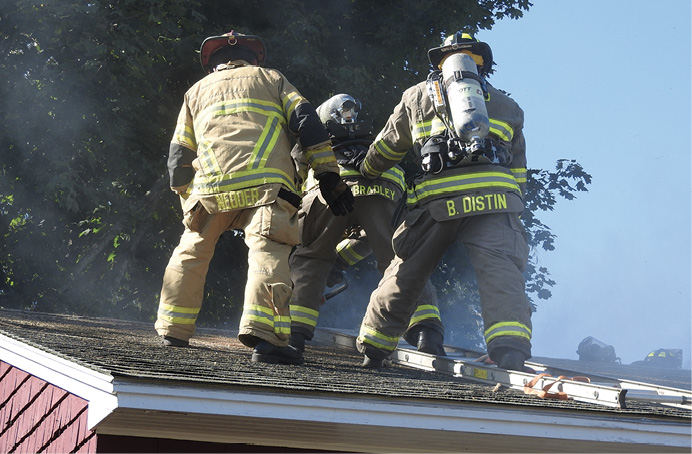
VOLUNTEERS CORNER ❘ By Joe Nedder
When I ask firefighters to tell me about risk management, a variety of responses come forth. They talk about multiple risk management systems, “risk a lot to save a lot,” and community risk programs, but the most frequent response is SILENCE! Why do you think that is? Think about it; what do you really know and, more importantly, understand about risk management? For most of us, the honest answer is “Not much.” And, we need to be honest when addressing this topic.
There are many aspects involved in managing risk. It can get very involved and overwhelming. Simply put, risk management is the act of trying to control things that can cause injury or death. This is a lot simpler to understand than the definition in National Fire Protection Association (NFPA) 1250, Recommended Practice in Fire and Emergency Service Organization Risk Management (Section 3.3.25): “the process of planning, organizing, directing, and controlling the resources and activities of an organization in order to minimize detrimental effects on that organization.”
RELATED
Risk Management: Improving Incident and Organizational Success
A More Definite Risk Management Model
Risk Management: It’s Not Just a Catchphrase
When many of us try to go deep into reading up on risk management, we get lost in a sea of intellectualism and complexity. We need to find ways to simplify things and reduce our risk.
Training as a Way of Reducing Risk
I am advocating as a method for reducing risk one that does seem to be excluded from virtually all risk management programs I have looked at: training in the basics, and then some. It is not mentioned in the NFPA 1250 standard.
Stop and think about this: Our job as firefighters is risky and dangerous. When we joined the fire service, many of us were trained on the basics. The manner, intensity, and curricula of this training still vary. But, we can all agree that learning to do the job as a firefighter is very important to our safety and survival. Learning about risk management is important, and using a risk management system on the fireground is important.
But, let’s go back to where the rubber meets the road. How well can you and your fellow department members do your job? It is a very fair question. Please don’t give the response, “We’re only volunteers,” because that is a copout, an excuse for not to be proficient at the job and to be lazy and not train. Many National Institute for Occupational Safety and Health line-of-duty death reports call out lack of various training skills as contributing factors in many of the deaths.

(1) Ladder rescue carries are an important skill, but they are also risky for firefighters who have had minimal training on the techniques and skills. When was the last time you conducted ladder rescue training? (Photos 1-2 by author.)
Today, there is much discussion about how committing time to training is becoming more and more of an issue in the volunteer fire service. I understand time and family commitment. I began in the fire service in 1976. I was married; shortly thereafter, we had two kids, one car, a stay-at-home mom, and I traveled a lot. My commitment to the volunteer fire department was a strain on family life, but I recognized its importance, my wife supported me, and we made it work.
We need to learn our basic skills and maintain them. The only way to do this is to train frequently. We don’t have enough calls to say we gain experience through incidents. If you want to be a firefighter and do all you can to return to your family after a call, you must maintain your skills. You do have the options of quitting and staying home or finding a nonfire role in which you can assist. No offense is meant to our senior members who fulfill these functions because they recognize that time and age slow us down and they also want to go home or to those who have volunteered to fulfill this function to assist in the community. Thanks to you for your service.
Training Program Essentials
At a minimum, we must meet or exceed the requirements of NFPA 1001, Standard for Fire Fighter Professional Qualifications. There are many fine curricula you can follow. Select one and use it.
However, before getting into curriculum, let’s look at some of the basic tenets of good training. To be effective, training needs to be punctual; safe; pertinent/applicable; consistent with accepted practices; to the point; as realistic as possible without compromising safety; and fun (training should be challenging, sweaty, and enjoyable)!

(2) Working on the basics means working all tools available to your department. When was the last time you conducted hands-on gas saw training?
Your members are giving of their time; respect that by making it worth their while. Evaluate your training program relative to the following questions:
- If I walked in on your training night, what would I see? People participating or people standing around? Did you start on time? Can the instructors do the drill, or do they just tell the trainees how to do it? Are the instructors knowledgeable about the subject, or are they faking it? Is there the proper equipment for the drill? If it is a self-contained breathing apparatus (SCBA) drill, are you using air or just faking it so you don’t have to fill the bottles after? (I’ll bet this sounds familiar to some.) Are the officers actively participating, or are they just standing around watching because they said they were “all set”? If so, you might have to question their abilities in skills and leadership. Do you see where I’m going?
- If I asked members, one on one, what they thought of the training, what would they say? Would they consider it a waste of time? Would they mention, “The instructors can’t even do it”? Would they say they consider the training not applicable or realistic to the job? Would they be upset because training never starts on time and always finishes late? Get the point?
- What do you really think of the training? Be honest. Does your response line up with what the members are saying, or do you disagree? If there is a disconnect, why? Times have changed. Are you current or stuck in the “That’s the way we do it here” syndrome? There is an old saying that goes something like this: “If you can’t find the solution, you might be part of the problem.” Training saves lives—ours! Are you still the right person for the job?
Even without support from the “top,” I have always found that there is a group of members who want to train. Why deny them?
How Much Training?
Let’s begin with how much training to do. This is a topic that many ignore or hide from. Should training be mandatory? The answer is yes! If you don’t train, how do you learn and then retain? Are you afraid of losing members if you have mandatory training? Look at whom you might lose—those who never show up (except for social functions). Again, the “I’m all set; I know what I’m doing” syndrome is not a good or safe practice.

(3) When training on opening up a roof safely, skill and supervision from the instructor are needed. (Photo by Robert Gatchell.)
A minimum of 48 hours of training a year has been one recommendation. I think that 72 hours minimum a year is more in line with the dangers of the job. That is only six hours per month. Come up with a number and stick with it. If you want a percentage of training, first set a target of minimum hours and then make it work to your percentage. I have seen 90%, 75%, and 50%. I think 50% is ridiculously low unless you are training 150 to 200 hours a year. Whatever you set, stick with it. The more training opportunities, the better. Will there be a firestorm of complaints and maybe some “turning in their gear”? Perhaps, but look at what is happening to the capabilities and skills of your members who embrace the training. Are you getting more and more capable and proficient as a department? If so, that far outweighs the negatives.
Training Components
Start with back to basics. One of my fire service heroes is Lieutenant (Ret.) Pat Lynch of the Chicago (IL) Fire Department. Lynch always told me that great firefighters need to constantly work on “executing our basics to the fullest.” Sage advice. What this means is that everything we do is built on our firefighting basics. If we don’t keep our basics current and sharp, how can we feel that we are always ready to do the job when called on?
A question I always ask is, “What are the two key things that put out the fire?” As you might expect, one response is always water. I agree, but that is number 2. What’s number 1? The answer is, great hose handling! If you can’t get the nozzle to the fire, you won’t be able to apply the water. How often do you drill on hose handling and movement? Is it realistic? Or, are you standing up and dragging the hose across the pavement?
What about ladders? How often do you drill on ladder raises? If you are a small or a shorthanded department, do you really work on one-firefighter 24-inch ladder carries and raises? If not, why? It’s most likely a very realistic situation for your department.
What about SCBA training, driver training, pump training, and search and rescue training? The list goes on and on.
What about officer training? Does your department offer any officer training? Are there training qualifications for those who want to be officers? Length of service, ample meeting attendance, washing the fire engine every Sunday, and being an active member do not necessarily qualify one to be an officer. They are all noteworthy qualities, but how do members develop the skills and fireground qualifications to lead firefighters into combat? Officer training is a key to company safety and to getting the job done.
Officer training for volunteers is deficient. Most officer classes are based on NFPA 1041, Standard for Fire and Emergency Services Instructor Professional Qualifications, and contain little on fireground operations and other necessary subjects. When training officers, you cannot assume that one size fits all! As volunteers, we need to recognize that we need to have exceptional basic and advanced skills. Can you physically and very skillfully do the job?
“10 Foundation Stones of Knowledge”
Other areas in which officers (and, frankly, most firefighters) need to be skillful are those I have identified as the “10 foundation stones of knowledge.” They are listed below:
- Effective leadership.
- Fire behavior (including modern fire behavior).
- Reading and interpreting smoke.
- Decision making on the fireground.
- Understanding strategies, tactics, and tasks; incident action planning.
- The brief initial report.
- Initial and ongoing size-up.
- Building construction.
- Risk management.
- Accountability and crew integrity.
All of these items are officer basics. Every officer in every volunteer fire department needs to know and understand these 10 subjects regardless of how small the department is. If you enter or send firefighters into burning buildings, you need to know and understand this material. We as volunteers need to step up and get this type of training so that we can operate safely and help to reduce or minimize the risks we all face at a fire!
I was once asked what I thought the most difficult job in the fire service was. Without hesitating, I said, “The training officer.” I still think that is the correct answer. Most take the job with energy and ideas on how to improve their department’s training. Yet, so many fall into the traps when confronted with issues associated with dealing with personnel and trying to keep everyone happy. It is a tough job. But, consider that if you persevere, gain support, and provide ample and high-quality training, your dedication will produce a positive effect on your fire department and the safety of those you serve.
Training and repeated training build proficiency and skills. They are the keys to everything we do! Training will help your department to operate more safely. A real risk management program begins with training. Failure to recognize this might mean you are playing Russian Rroulette with your members’ lives.
JOE NEDDER was an on-call firefighter for 36 years, serving in various ranks. He retired from the Uxbridge (MA) Fire Department in 2013. In 2018, the Mendon (MA) Fire Department brought him out of retirement to organize and improve the department’s training as its training officer. He has been involved in training for more than 30 years and has taught at FDIC International from 2010 to 2020. He has been published in Fire Engineering. He is the founder of and lead instructor for Cross St. Associates. He is the author of Rapid Intervention Crews (Jones and Bartlett) and soon-to-be-released Managing Risk in the Volunteer Fire Department (Fire Engineering).

